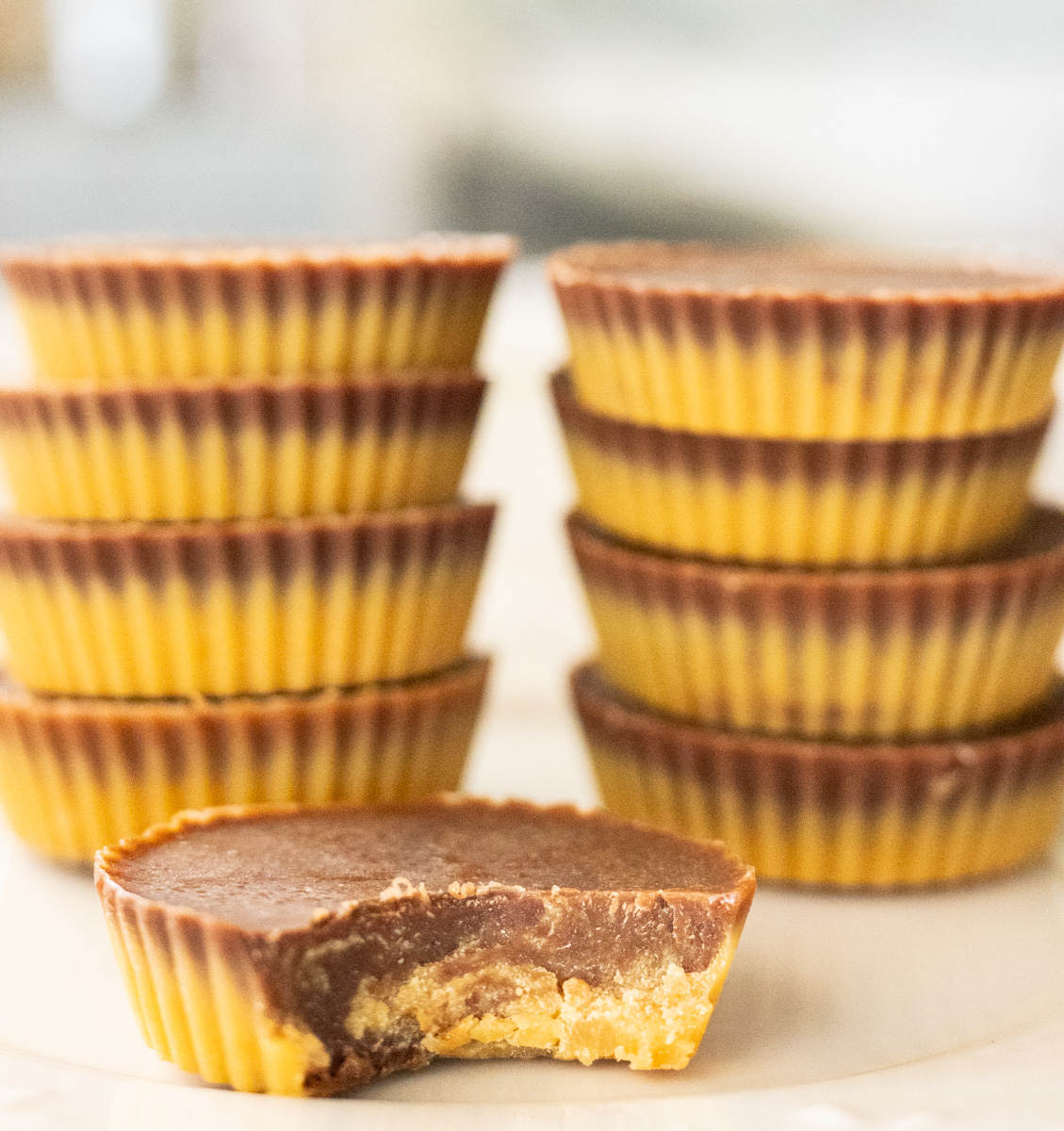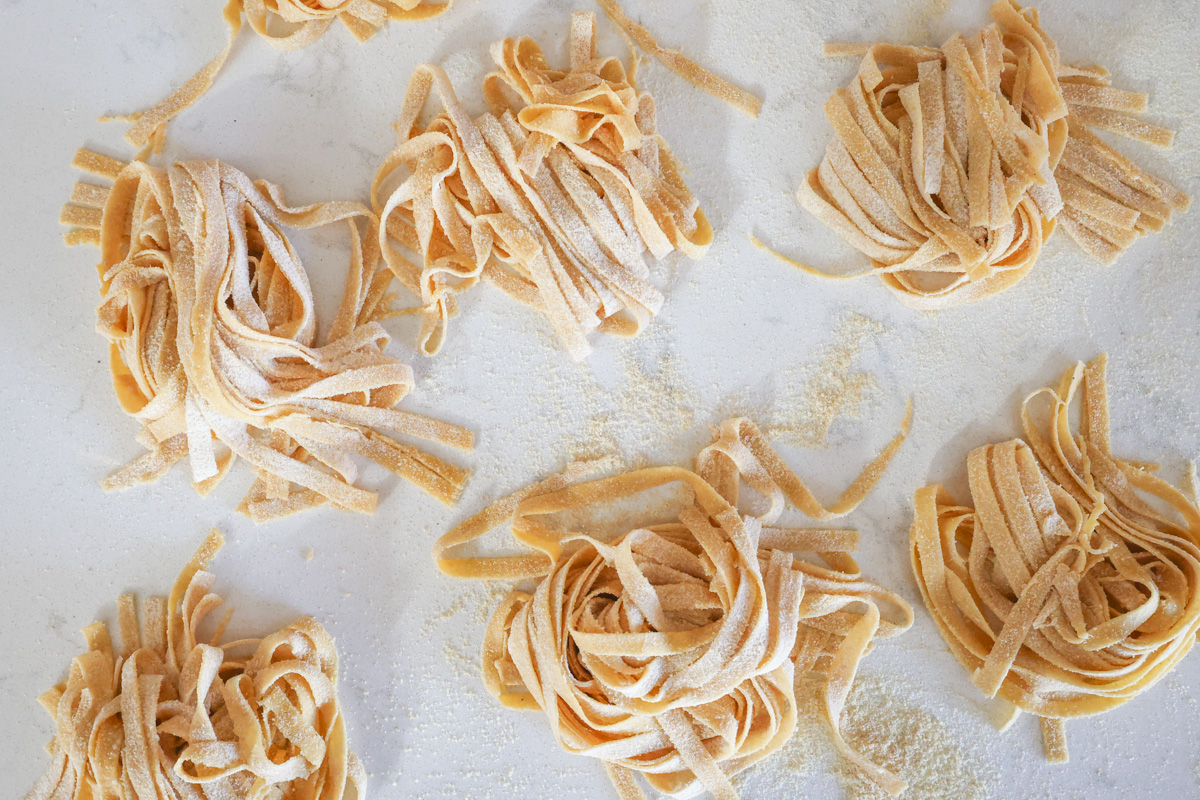How to Use Flat Cloth Diapers for Baby {& Why I Love Flats!}
Flat cloth diapers are the most affordable option for cloth diapering, less bulky than other options, easy to keep clean, and easy to stock up on! Let’s discuss everything you need to know about flat diapers.
Cloth diapering is making a comeback and there are tons of options – but the most overlooked option is, in my opinion, the BEST – flats! Yes, flat cloth diapers like your great, great grandma used are the cloth diapers of choice for this mom of 5. A flat diaper or “flat” looks just like it sounds, like a flour sack cloth.

I’ve cloth diapered each of my babies in some capacity, but until baby #4 I had never used flats because I was intimidated by the folding and wrongly assumed it would be a lot more time-consuming and wouldn’t work as well as the more expensive cloth options like pocket diapers or all-in-ones.
I was talked into trying flats for baby #4 and have never looked back! As I write this post, baby #5 is due very shortly and I already have a stash of newborn flats prepped and ready to go. I love knowing that my new baby will be clothed in natural fibers like cotton and wool rather than toxic disposables. (but I do keep a few disposable diapers on hand just in case!)
Let’s discuss all things flat diapers.

I may receive a small commission for items purchased through affiliate links in this post at no additional cost to you.
How Much Does it Cost to Diaper a Baby Using Disposables?
Well, this depends on the kind of disposables you use. If you can find a very good deal on more natural disposable diapers, you’re going to pay about $0.32 per diaper. At minimum 12 diaper changes a day for a newborn-3-month-old baby, that’s a total of $345.60 to diaper a baby using disposables for the first 3 months.
You can cut this price in half by using the cheapest disposables you can find, but they will be harsh on the baby’s skin and expose the baby to lots of toxins, plus potentially lead to more diaper rashes.
If your baby potty trains very early at 18 months and we are very generous in assuming only 6 diaper changes a day from months 3-18, the total cost of diapering baby during that time period at $0.32/diaper would be $864.
So let’s add those numbers up – $345.60 + $864 for diapering a baby for 18 months with minimal diaper changes comes out to $1209.60…..to diaper ONE baby using disposables.
Now let’s be real. Most babies are not potty trained that young, require changing more often, and inflation is through the roof so diaper pricing is often higher. Realistically you’re probably looking at double that for ONE baby, that’s $2420 to diaper ONE baby, since unlike cloth diapers, disposables can’t be reused for multiple babies.

What is a Flat Diaper?
A flat diaper is a type of cloth diaper made from a single, large, rectangular or square piece of fabric – usually cotton or a blend of cotton and other fibers. Flats are versatile and can be folded in many ways to fit a baby of any size, allowing for customizable absorbency and coverage.

They require folding and fastening with pins or diaper fasteners before use and an outer waterproof cover like a PUL cover or Wool pants. Flats are cost-effective, easy to wash, and quick to dry. They’ve been used for ages for diapering.
Why I Love & Exclusively Use Flat Diapers
- Flats are CHEAP. Like, dirt cheap. Especially when you compare them to other types of cloth diapers like pockets or all-in-ones. A quick Google search shows that pocket diapers run $10-20 a pop. Quality, organic flat diapers, on the other hand, cost about $2.75 apiece. We will talk about how many you need shortly, but just say for a newborn you decide to keep 36 cloth diapers. At $10 a piece, pocket diapers will cost $360, and that’s just for the newborn phase. 36 flats would cost $99. That’s a big difference!
- Flats are a lot less bulky and have a better fit. Because flats are one layer of fabric, they’re flexible even when folded and I have had the absolute fewest leaks and blowouts using flats as opposed to other types of cloth.
- Flats are easier to keep clean and smelling good. Once again, because flats are just one, single layer of fabric folded up, they unfold in the wash and get completely clean. There aren’t tons of layers sewn together for poop and potty to get trapped in.
- Flats (and almost all cloth diapers) can be reused for multiple babies. If you use natural fibers like birdseye cotton, hemp flats, hemp jersey, etc. – the material will eventually break down and need to be replaced. But I have stretched my organic cotton cloth on 2-3 babies before needing to replace my stash.
In this video, I’m chatting about all things flats and showing you my stash for baby #5!
What You Need to Cloth Diaper Using Flats
While you can use one-size flat diapers on babies of all ages – newborn through potty training, I really recommend purchasing a newborn stash and a one-size stash. Newborn flats are smaller and a lot less bulky on a newborn through 3-month-old baby. Once baby starts to fill out a bit the one-size flats work great!
Don’t be fooled by the pocket diapers or all-in-one cloth diapers that are marketed as one-size-fits-all all, they’re almost always too big for a newborn so they aren’t truly one-size, this is just another reason flats are my favorite option – it’s so much cheaper keeping a stash of all the appropriate sizes you need.
When using flats, you’ll still need to purchase diaper covers of some sort so you will need different sized covers. The cover you use for a newborn won’t work for a 12-month-old, this is why I have two separate stash or supply lists – one for newborns and one for bigger babies because you can definitely get by with one-size cloth diaper covers for bigger babies.
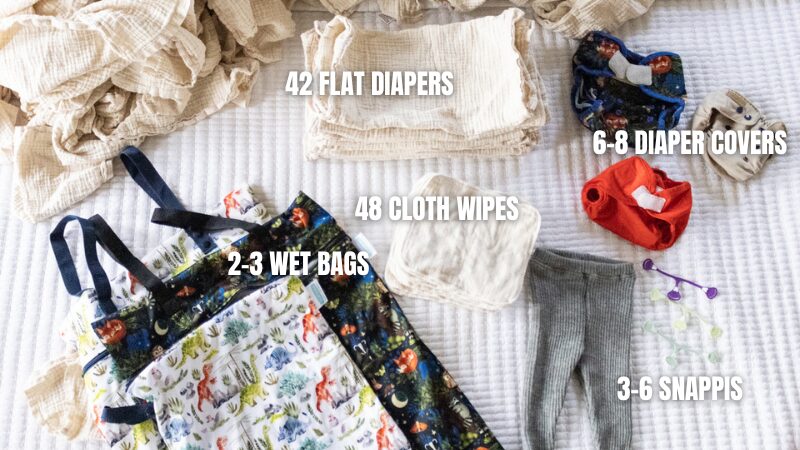
NEWBORN STASH
- 24-48 newborn flat diapers (newborns poop a lot, you need at least 12 cloth diapers a day)
- 5-6 fasteners like pins or snappis
- 6-8 newborn or 0-3 months PUL covers AND/OR
- 4-6 newborn or 0-3 months wool covers
- 2-3 wet bags
- (optional) 48-60 cloth wipes
- spray bottle for wetting cloth wipes
3 MONTHS THROUGH POTTY TRAINING STASH
- 24-48 one-size flat diapers
- fasteners like pins or snappis
- 6-8 one-size PUL covers AND/OR
- 4-6 wool covers in each size as baby grows
- 2-3 wet bags
- (optional) 48-60 cloth wipes
- spray bottle
How Much Does it Cost to Cloth Diaper Using Flats?
Let’s break this down using the supply list I included above. I personally purchase my organic cotton flat cloth diapers from Green Mountain Diaper and love all of the cute new releases and beautiful color and patterns. But if you’re a Prime member and want to take advantage of free shipping – I have purchased cloth supply items from Amazon as well and have been pleased with the quality. Check out my Amazon Cloth Diapering supply list here.
I love Green Mountain’s selection results of organic cotton diapers such as flats, prefold cloth diapers, and fitted workhorses. And they send a full page of instructions on cloth or wool diaper use and care with every order. The content of this store is top-notch.
We will break down the cost of cloth diapering a newborn and a 3-month-old through potty training, which will give us the total cost of cloth diapering from birth to potty training.

COST TO CLOTH DIAPER A NEWBORN/0-3 MONTH OLD BABY
- 42 newborn muslin flat diapers (7 packs of 6 at $16.50 each): $115.50
- 8 Rumparooz/Kanga Care newborn PUL diaper covers ($10 each): $80
- Snappi closures: (pack of 5): $13.95
- Wet bags (set of 3 different sizes): $14.99
- Cloth wipes (4 packs of 12 for $12.95 each): $155.40
- Spray bottles: $9.99
Keep in mind that some of these items like wipes, wet bags, snappi closures, and spray bottles will be used beyond the newborn/0-3 months phase and do not need to be repurchased. The only newborn-specific costs are the newborn flats and newborn PUL covers.
NEWBORN FLATS + NEWBORN PUL DIAPER COVER COST: $195.50
TOTAL COST OF CLOTH DIAPERING A NEWBORN/0-3-MONTH-OLD BABY: $389.83

COST TO CLOTH DIAPER A BIGGER BABY
*if you already have the supplies from your newborn stash*
- 42 one-size muslin flat diapers (7 packs of 6 at $21.95 each): $153.65
- 8 Rumparooz/Kanga Care one-size diaper covers ($14 each): $112
TOTAL COST OF CLOTH DIAPERING A BIGGER BABY: $265.65
If we add this total to the newborn full stash total, the result is…
TOTAL COST TO CLOTH DIAPER A BABY USING FLATS: $655.48
That’s a ton of savings compared to the costs we listed earlier for disposables, and keep in mind these cloth diapering supplies can usually be stretched for at least 2 babies!
Earlier we calculated the cost of diapering one baby in disposables and got a wide range depending on how long before they potty train, how often you change them, and the quality of diapers. For comparison’s sake, let’s just say it costs $2000 to cloth diaper ONE baby.
The savings from using flats is over $1300!
And if you use your stash for 2 babies, the savings is over $3300, and so on…
This is how you have lots of babies without breaking the bank – you go old school!

How to Use Flat Diapers
We’ve covered what you need in your stash, now let’s talk about putting your cloth to use.
First of all, let’s review what you need when diapering a baby using a cotton diaper like a flat, fitted diaper, or prefold diapers: You will need the inner cotton piece (flat), a closure like a Snappi or pin, AND an outer, waterproof cover (can be a PUL cover or a wool cover)
First, you will fold the flat to fit to baby’s shape using one of the various folds for flats. I personally prefer the Kite and Neat folds, both folds work great on any size baby. I’m including the origami fold as well since it’s also a popular option. Let’s take a look…
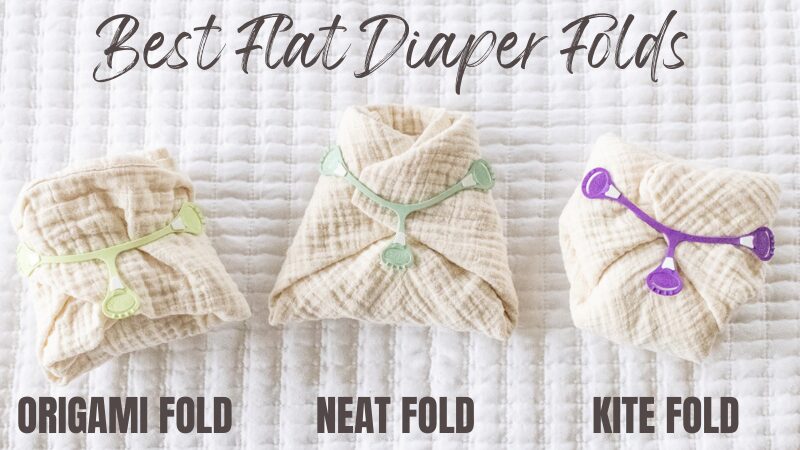
HOW TO FOLD A FLAT DIAPER
If you’ll be starting with a rectangular flat (most newborn flats are rectangular) always fold one of the short sides over onto the flat to make a square before you begin your fold. If you’re using a one size flat this will not be necessary since they are already in the shape of a square

NEAT FOLD
- Start with a square, so if your flat is rectangular, fold one short side over into the middle to make a square.
- Fold the bottom left corner up into the middle of the square.
- Fold the top right corner down into the middle of the square to meet the opposite corner you folded in step 2.
- Fold the bottom right corner up and along the flat edge created in step 2.
- Repeat with the top left corner corner.
- Turn the diaper to face you, it is now shaped for baby.
- Bring the bottom up and around baby
- Bring the sides around baby and fasten the diaper
- Put a diaper cover on baby and you’re good to go.
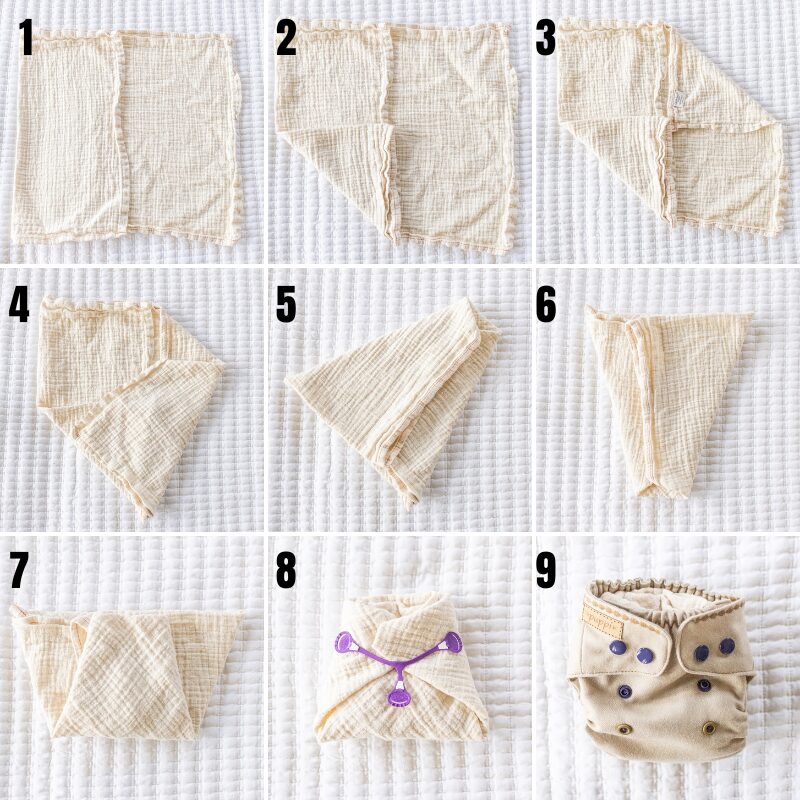
KITE FOLD
- Turn the square flat diagonally
- Fold the left corner into the middle
- Fold the right corner into the middle so the flat looks like a kite (hence, kite fold)
- Fold the top down like the top of an envelope
- Fold the bottom up to meet the top piece in the middle of the diaper
- Fold the left corner over to the middle of the diaper
- Repeat with the right corner, so this diaper now looks like a thick pad
- Fold the top corners down while keeping the bottom folded like a pad. The diaper is now shaped for baby.
- Fold the diaper around baby by bringing the bottom up and the sides around to the front, then fasten and place a waterproof cover on baby.

ORIGAMI FOLD
- Start with a square
- Fold the flat up in half
- Fold the flat across in half
- Grab the top right corner of fabric and pull it over to the left
- Grab the top corners of the flat and flip it toward you so it is upside down
- Take hold of the right edge and tri-fold it in to the center of the diaper so you have a thick pad in the center with a triangular wing on either side.
- Turn the diaper so it is facing you, it is now shaped for baby.
- Bring the bottom up around baby
- Bring the sides around baby, fasten the diaper, and cover with a waterproof diaper cover.

CLOTH DIAPER CLOSURES
The two most popular options are Snappis and pins. Pins are cheap and easy, but if you’re worried about poking baby or other kids getting ahold of them, snappis may be the best choice. I prefer snappis for this reason and keep several on hand – a few in my diaper bag, a few in my diaper cart at home, and extras in the nursery in case I can’t find one.

CLOTH DIAPER COVERS
You will need waterproof outer covers when using flat diapers. You can use either PUL covers or Wool covers. Wool is much more expensive (unless you make your own) but if natural fibers are important to you and you want to cut down on laundry and leaks, wool is the best option. I have a combination of PUL covers and wool covers, but I prefer wool.

CHANGING AND WASHING CLOTH DIAPERS
Breastmilk poop is totally water soluble, so soiled diapers from babies who are exclusively breastfed do not need to be rinsed before washing. Just remove the dirty diaper, wipe baby clean, and place the dirty diaper and cloth wipe in a wet bag until you’re ready to wash. Run soiled diapers through a rinse cycle and then a wash cycle with your favorite natural laundry detergent ( I make my own and it works great for flats and in HE machines). Then dry the diapers and you’re ready to go.
Tips
- If using snappis as closures, be careful if also using wool. Snappis can catch in wool and snag it which can ruin it.
- Fold your flats straight out of the dryer when you have time so they’re quick and easy to grab and go with baby.
- Line dry your flats as often as possible which is easier on the fabric and keeps them fresh longer.
- Request a gift card to your favorite cloth diapering store on your baby shower registry.
- Add a folded cloth wipe into the center of the diaper for extra night time protection.

SHOP MY COMPLETE AMAZON CLOTH DIAPER SUPPLY LIST HERE
I will be adding more posts on cloth diapering in the weeks and months to come, so if you haven’t already joined my email list, do so and you’ll get updates when I have new cloth posts!

